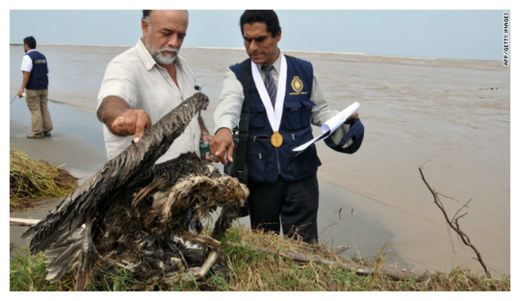
At least 2,300 dead birds were found along beaches between Cartagena and Playa de Santo Domingo, Chile, said Jose Luis Britos, and environment professor and director of the Museum of Natural History of San Antonio, Chile.
Many of the birds, which come from several species, had broken wings and bruising on the outside of their bodies -- injuries consistent with getting trapped in fishing nets, Britos said.
He said bird deaths from fishing nets occur every year, but never at this level. In a typical year, about 15 to 20 dead birds are found, Britos said.
One hypothesis for the increase this year involves climate.
As Chilean weather gets colder this time of year, migrating birds that would normally travel north for warmth are instead lingering to feast on an influx of anchovies and sardines that had fled the coast of Peru in search of cooler waters.
Earlier this week, Peruvian authorities say warm waters off that country's coast are to blame for the deaths of more than 5,000 marine birds.
The Peruvian National Center for the Study of El Nino said that since February, the Peruvian coast has had an abundance of warm water as a result of marine currents throughout the world's oceans. The warm water has altered the marine ecosystem, it said.
The warm water has led fish such as anchovies and other species that live in surface waters to migrate to deeper water toward the south. As a result, pelicans and other birds that feed from the surface of the water died of starvation.
"If these oceanographic conditions persist, it is likely that its impact will spread to other areas of the (Peruvian) coast even during the fall, which could make the numbers increase and affect other marine species," the report stated.
The Peruvian ministry of environment said seafood is still safe to eat, and encouraged everyone to continue to support local fishermen, according to state-run Andina news agency.
Officials in Peru continue to search for the cause of death of almost 900 dolphins since the beginning of the year. The health ministry is awaiting final results from molecular analysis looking for the morbillivirus, which previously has been linked to dolphin deaths.
The Chilean agriculture and livestock ministry and staff from Britos' center have called for a meeting with fishermen for Monday. They are asking fishermen to try to save trapped birds before closing their nets.
Britos said he worries that until Monday, the number of dead birds could rise significantly.



Reader Comments
to our Newsletter